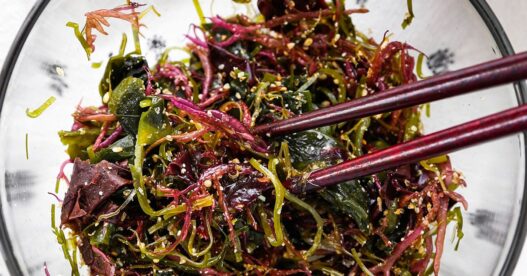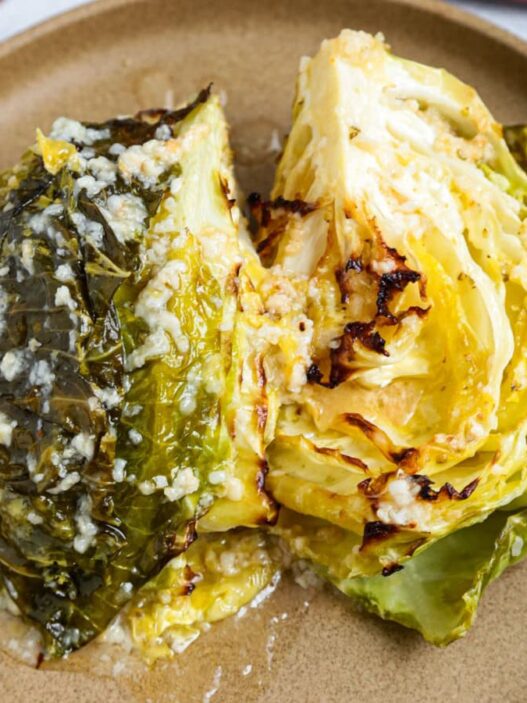I've always been a huge fan of Japanese seaweed salad! With its tangy and slightly briny taste, it makes for a tasty and refreshing side. What's also great is how easy it is to make at home. My seaweed salad recipe comes with a soy and sesame dressing and is ready in about 15 minutes.
If you are wondering if this recipe is the delicious tart and nutty seaweed salad found in most Japanese restaurants across the globe, the answer is yes! This isn't sunomo, which is a dish made of seaweed and sliced cucumber dressed in vinegar, but rather the colorful bowl of algae served with a soy sauce, rice vinegar, and toasted sesame oil dressing.
The level of acidity found in this seaweed salad is heaven for someone like me who thrives on tart and sour foods! It's puckery sour and hits the spot whenever I want a dish that's both punchy and refreshing. This seaweed salad never disappoints and only takes 15 minutes to make from start to finish.
Ingredients
- Seaweed: I recommend using a mixture of dried seaweed so there is more variety in texture and color. Some of the more seaweed used in kaisou salad are wakame, red and green tsunomata, seaweed stem, mafunori, and agar. No need to purchase them separately as mixed seaweed packages can easily be found in Japanese supermarkets (sometimes in Chinese grocery stores too). If you cannot find it, you can still make this salad using only wakame.
- Toasted sesame oil: Make sure to use toasted sesame oil and not just regular sesame oil. That's because the flavor of toasted sesame oil is much more concentrated and will give the vinaigrette a deep nutty taste.
- Soy sauce: Use regular Japanese soy sauce if you can. Korean soy sauce and Chinese soy sauce are also okay.
- Rice vinegar: Use plain rice vinegar to infuse tartness and a little fruitiness. Apple cider vinegar can be used as an alternative.
- Mirin: Mirin has a slight sweetness and is rich in umami. It helps balance the salty and acidic flavors of the dressing.
- Sugar: A little sugar is added to also balance the salty and acidic flavors.
- Ginger: Only fresh ginger should be used to infuse the dressing with some warmth and a little heat.
- Ground sesame seeds (optional): You can buy ground sesame seeds or crush them yourself. Simply use a pestle and mortar or a Japanese sesame grinder (that's what I use) to grind them.
Variations
- Make it spicy: Top the salad with some thinly sliced dried red chilis, or a sprinkle of ichimi togarashi.
- Make it sweet: Add a little extra sugar to the dressing or a drop of honey for sweetness and a floral element.
- Make it creamy: Add 2 to 3 tablespoons of Kewpie mayonnaise or regular mayonnaise to the dressing.
- Make it more filling: Add sliced cucumber, cubed tofu, and/or crab sticks. Or top it with some canned tuna or shredded chicken.
- Add some greens: Add crispy lettuces leaves to lighten up the salad and make it more interesting texture wise.
How to Make It
- Make the seaweed salad dressing by whisking the sesame oil, soy sauce, rice vinegar, mirin, sugar, and ginger.
- Place the dried seaweed in a bowl of water and let pieces soak for 5 to 10 minutes – or follow to the directions on the package.
- Drain the seaweed well and gently squeeze out the excess water using your hands.
- Toss the seaweed with the dressing and add the ground sesame seeds. Toss again and enjoy!
Expert Tip
Drain and rinse the seaweed a few times: Once the seaweed is rehydrated, drain and rinse it a few times in cold water to remove some of the fishy smell. Some seaweed can have a strong odor that can unfortunately ruin the overall dish if it's not handled properly. Using cold water will also make the salad taste more fresh.
Storage
- Seaweed salad doesn't keep well because the texture of algae gets slimy after it's been rehydrated for a few hours. For the freshest salad I recommend serving it within 2 hours after it's been mixed with the dressing.
- Make ahead: The dressing can be made ahead of time and keeps well in the fridge for up to 1 week.
What I Like To Serve With My Seaweed Salad
Japanese seaweed salad should only be enjoyed in small quantities because of its high levels of iodine, which can cause problems with the thyroid. Because of that, it's usually served as a side dish with other traditional Japanese foods. I personally think it pairs well with just about anything! Some of my top dishes that I like to serve with seaweed salad are:
Other recipes using seaweed that you might like: Wakame and vermicelli soup, traditional tofu and seaweed miso soup, sunomo (Japanese cucumber vinegar salad), Korean seaweed soup (tofu miyeok-guk), hijiki salad, bukkake udon, and homemade furikake.
Frequently Asked Questions
Yes, this salad is 100% vegan.
No, this salad isn't gluten-free because the dressing is made with ingredients that contain gluten. However, it can easily be made gluten-free! Instead of regular soy sauce, use gluten-free soy sauce or tamari, and make sure that the mirin and rice vinegar used is also gluten-free (some of them are made in facilities where cross contamination may happen, so it's always good to check the label or information about the brand).
Yes you can but keep in mind that the overall taste will not be exactly the same. Perilla seed oil and walnut oil can be used as substitutes, and make sure to use plenty of ground sesame seeds to increase the level of nuttiness!
Did you like this recipe? Are there changes you made that you would like to share? Share your tips and recommendations in the comments section below!
Print
Description
This Japanese seaweed salad is tangy, savory, and refreshing, and makes a delicious side to other traditional Japanese dishes.
- Make the dressing: Whisk all the ingredients for the dressing in a bowl and set aside.
- Rehydrate the seaweed: Place the dried seaweed in a bowl of cold water and soak for 5-10 minutes (follow the instruction on the package).
- Rinse the seaweed: Drain and rinse well under cold water. Drain again and squeeze out excess water from the seaweed using your hands.
- Mix the salad: Place the seaweed in in a bowl and pour the dressing on top. Toss well and sprinkle ground sesame seeds on top. Serve on its own or topped with slices of fresh cucumber and tomato.
Notes
Seaweed salad tastes best when eaten fresh because seaweed gets slimy over time. Eat within 2 hours for the freshest taste and texture.
Nutrition
- Serving Size: 1 bowl
- Calories: 71
- Sugar: 3.9g
- Sodium: 407.3mg
- Fat: 4.3g
- Saturated Fat: 0.6g
- Unsaturated Fat: 1.8g
- Trans Fat: 0g
- Carbohydrates: 6.5g
- Fiber: 0.3g
- Protein: 1.5g
- Cholesterol: 0mg















